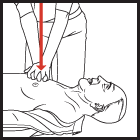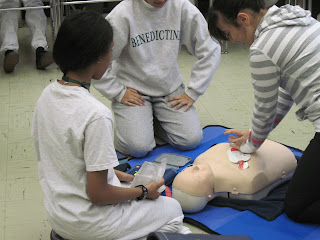 This past Thursday and Friday, several dozen students and staff were trained in cardiopulmonary resuscitation and in the use of an automated emergency defibrilltator.
This past Thursday and Friday, several dozen students and staff were trained in cardiopulmonary resuscitation and in the use of an automated emergency defibrilltator. Our JTB CLUB working with Atlantic Health Services and the John Taylor Babbitt Foundation arranged for this life-saving training at Benedictine Academy.
There are often only precious minutes between life and death.
At Benedictine Academy, we choose to be pro-active in making our school and the local communities a better place.
 Learn CPR is a free public service supported by the University of Washington School of Medicine. Learn the basics of CPR - cardiopulmonary resuscitation. The American Heart Association issued updated CPR guidelines in October, 2010. Check the victim for unresponsiveness. If the person is not responsive and not breathing or not breathing normally. Call 911 and return to the victim. In most locations the emergency dispatcher can assist you with CPR instructions. |  |
| 2. PUMP If the victim is still not breathing normally, coughing or moving, begin chest compressions. Push down in the center of the chest 2 inches 30 times. Pump hard and fast at the rate of at least 100/minute, faster than once per second. |   |
| 3. BLOW Tilt the head back and lift the chin. Pinch nose and cover the mouth with yours and blow until you see the chest rise. Give 2 breaths. Each breath should take 1 second. |
